The performance of any software application depends on the set of abilities embedded in it during this application’s design. A failure to provide any of such abilities to a sufficient extent is potentially fraught with many unpleasant consequences.
In the case of a legal document management system, such consequences include the system’s inability to support a growing customer base, the ever more rampant and costly data security compromise, a failure of the DMS to completely automate some of the business processes, and others.
This makes it of utmost importance to thoroughly take into account, list, and describe the diverse business and technical requirements your DMS is planned to satisfy.
In this article, we’ll take a close look at all these groups of legal document management system requirements to help avoid omissions, envisage risks, and achieve a more optimal performance for your legal DMS.
Why Defining Clear Requirements is Critical For Your DMS Project
Having clear requirements is a critical condition for the effective implementation of a DMS system, and here is why:
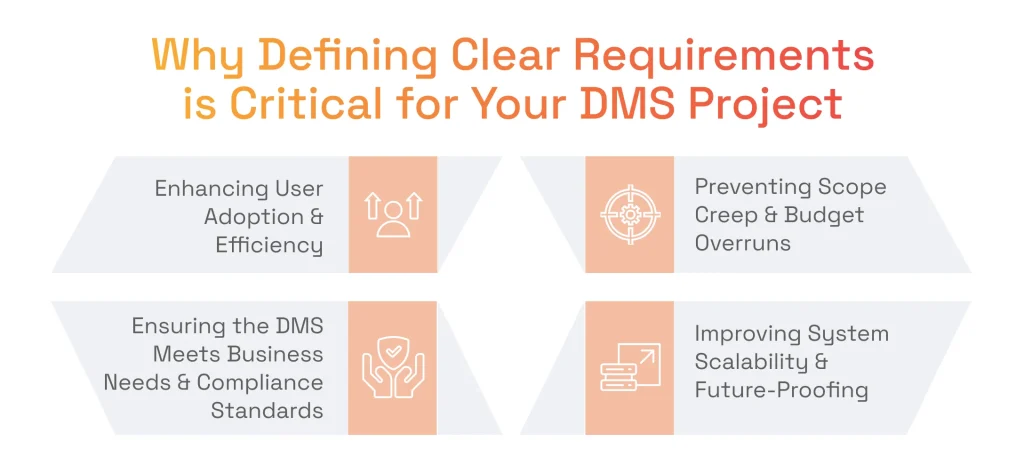
- Enhancing User Adoption and Efficiency: clear requirements allow customization of the system’s interface, search capabilities, and automation to match the needs of real users, enabling faster workflows and a more intuitive user experience.
- Preventing Scope Creep and Budget Overruns: with a structured approach, defined priorities, and key functionalities, there are more chances that the project will remain cost-effective. Having clear expectations from the start will help to avoid unnecessary expenses during the development.
- Ensuring the DMS Meets Business Needs and Compliance Standards: by having defined compliance needs from the start, you can be assured that the system includes necessary audit trails, encryption, and access controls.
- Improving System Scalability and Future-Proofing: your system will remain adaptable by expecting future expansions and functionalities from the very start.
Document Management System Requirements Classification
The system requirements for any software application fall under the four following categories:
- Functional requirements
- Non-functional requirements
- Operational requirements
- Legal and Compliance requirements
Let’s review each group in more detail.
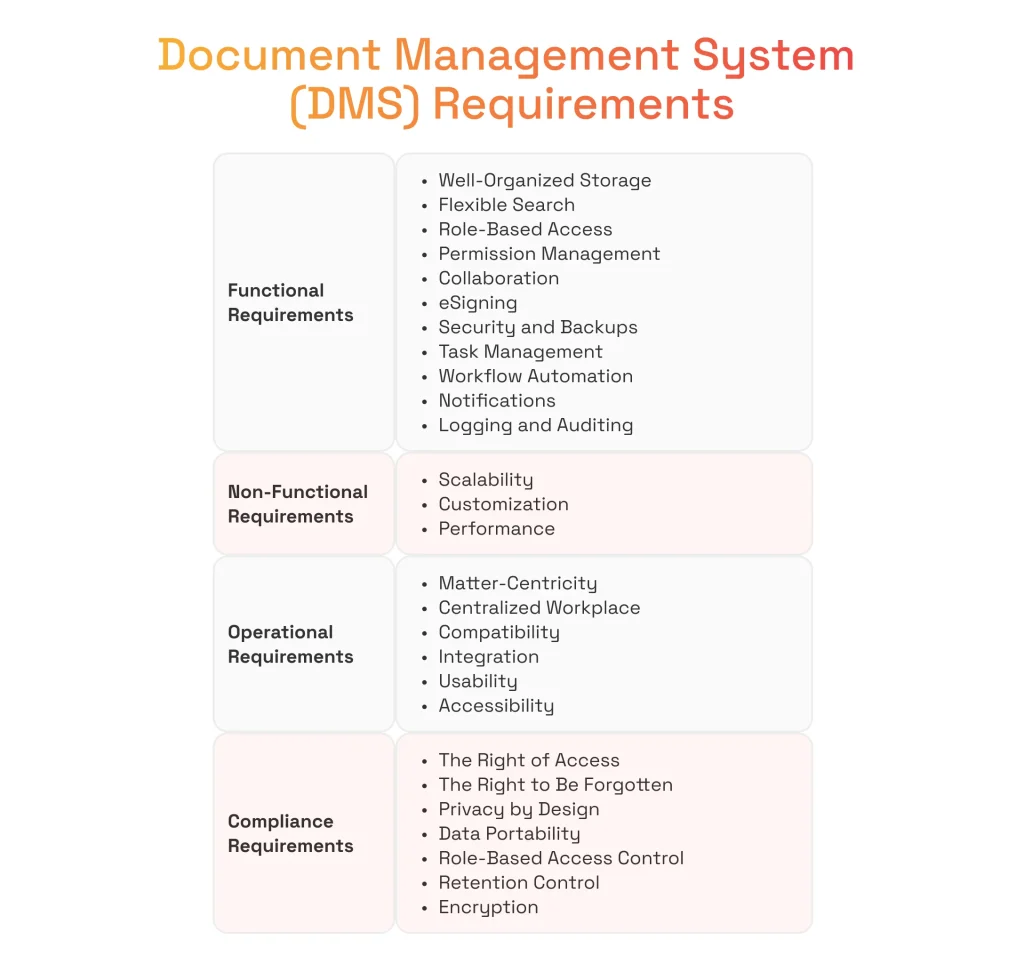
Document Management System Functional Requirements
The functional requirements for a document management system define the system components the DMS consists of, and would, at least partially, fail to fulfill its purpose without.
In other words, these requirements describe the features of your document management system. They also describe the actions these features perform (and not the way or extent to which they do so).
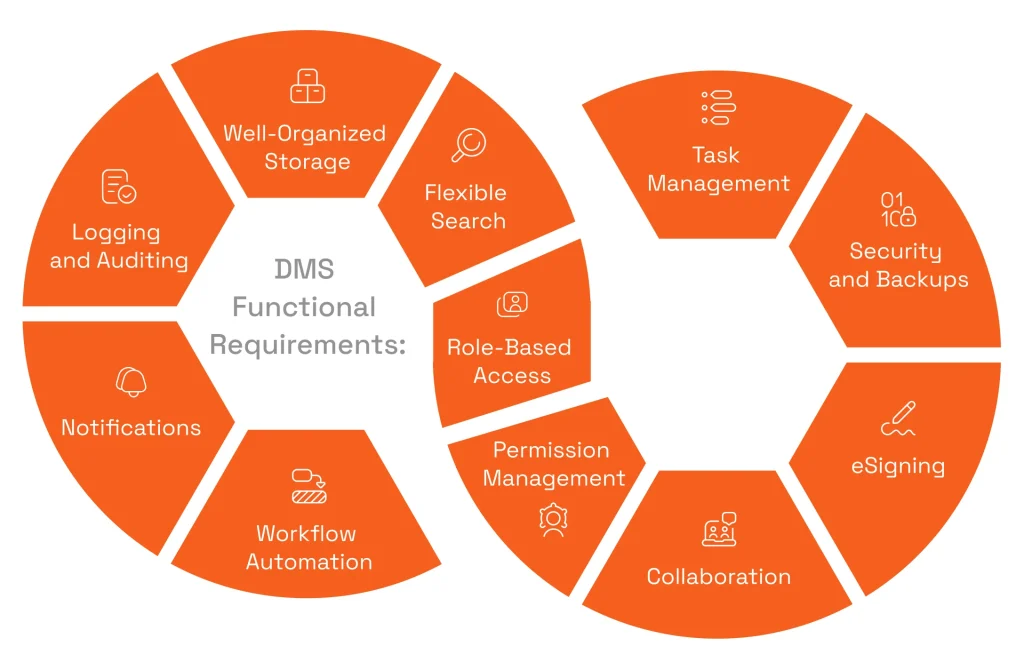
Well-Organized Document Storage and High Searchability
One of the main purposes of a legal DMS is to store documents in such a way that allows their quick and convenient retrieval. To enable this, the document base of your DMS must be searchable by multiple criteria. These criteria can include:
- Document Title
- Document Type
- Document Owner
- Document Number
- Customer Name
- Lawyer or Attorney Name
- Case
- Address
- Company Branch
- Company Department,
or any other keyword that is relevant to your company or its business situation. You should spend enough time on composing your list of keywords. Besides, this list must also be implemented as flexibly customizable in your system.
While defining your search-related DMS requirements, you must be aware that there are several types of document search your search functionality can include.
Your document base can be searchable only by meta data, or it can also be searchable by the contents of the documents it contains. Furthermore, there exist several technically and conceptually different types of search that may need to be implemented, like:
- Synonym-based search
- Fuzzy Search
- Proximity search,
and others. To achieve the document searchability you need, you should discuss all these options with your software provider and have the required ones implemented.
To enable effective metadata-based document search, your document management system must, first of all, allow for quick and sufficiently deep indexing of all the documents it contains: only properly and thoroughly indexed documentation allows your system to quickly locate the one or more documents you’re searching for. For this reason, your system’s indexing functionality must include the ability to add text, numbers, symbols, dates, URLs, and currency signs.
If this makes sense, you should also include any company-specific terms that your employees could use for searching purposes, like, for example, branch locations or names of the company’s departments or teams. If you have a large enough number of such company-specific terms, it may be better to implement this functionality as drop-down lists. Also, it’s better to have a standard vocabulary for all the indexes your users will use.

Artem Dyranov
Business Analyst & QA Engineer at SPD Technology
“A significant part of the requirements’ set would be the same for any other application. However, implementing things like matter-centricity and the role-related sharing rights takes quite a bit of industry-specific expertise.”
Role-Based Approach and Permission Management
Taking the Role-Based Access (RBAC) in managing access permissions is not only a compliance requirement (like, for instance, in the case of GDPR), but also a security necessity.
Under this approach, the underlying principle in managing access privileges is that any of the system users must be entitled to access only the digital assets they are authorized to work with in accordance with their position and work duties.
To implement Role-Based Access, you need to define the user roles for your DMS, detail the permissions associated with them, and clearly describe the objects that the defined permissions are issued for.
Furthermore, in addition to the permissions, it is also essential to detail the rights the user roles have, for example, whether a user in a specific role is authorized to share a legal document they have access to with users in other roles, or whether they can invite a user from outside the system to collaborate on a document.
As an example, we’ve implemented an intricate role-specific functionality. More specifically, we’ve implemented 7 different customizable permissions for 4 user roles, as well as different access patterns for each of these roles. It resulted in an improved the security level of the solution.
Collaboration and Sharing
Your document management system business requirements must meticulously describe your demands for the document-related collaboration your DMS must provide.
Users of your DMS must be able to edit the same document concurrently, or lock a document in order to prevent it from being edited in parallel by other users. Besides, it must also be possible for users to comment on the contents of a document. If that makes sense in your business context, the latter should include not only comments, but also the ability to draw over photos and pictures.
An essential requirement for a legal DMS would be the ability for users to conveniently compare two documents on screen. They should also have the ability to easily compare two or more different versions of the same document.
Lastly, system users in authorized roles should be able to share documents with users outside the system via an invite and enable these external users to comment on the shared documents.
eSigning
Your legal DMS must enable e-signing documents through an integration with a 3d-party service.
Prior to making a choice in favor of some eSignature provider, dial into the eSignature-related laws in force in your geography. Ascertain from your provider candidate that they are in a position to ensure compliance with these laws (in the case of the U.S, it’s the Electronic Signatures in Global and National Commerce (ESIGN), while in the European Union its the eIDAS regulation).
It is also worth mentioning that using the Blockchain technology creates some additional opportunities in terms of document integrity and security. For example, it gives you the ability to insert an e-signature or a QR code into a document.
Security and Backups
Security is of topmost importance in Document Management. Because of this, the security-related requirements should be spelled out most carefully in your document management system requirements specification.
First of all, your DMS system requirements should state that any documents your application is intended to handle are to be stored solely in its database, and not anywhere else. Aside from that, we wouldn’t recommend using any third-party services for document storage purposes.
Next, you must stipulate that all the data at rest in your system be encrypted using a strong encryption algorithm, like, for example, AES 256 or RSA. As it’s equally important to reliably protect data in transit, it is essential that all the traffic between your system and any user devices be automatically encrypted using TLS\SSL (our preference would be TLS).
Additionally, it is absolutely essential to impose strict requirements for moving data out of your system using any other means. Namely, the attachments of all emails that originate from your DMS must necessarily be automatically encrypted. Your system must automatically encrypt any data that is downloaded to a removable drive by users, who are authorized to perform this operation. It must immediately block any attempts by unauthorized users to download data.
In addition to securing your data, you need to secure user access to your document management system and the network it resides on. One can do this using such technical means and approaches, as Two-Factor or Multi-Factor Authentication, advanced Identity Verification (for instance Iris Recognition), Wall Access Firewalls, and others. Discuss the existing options with your software provider and see to it that the ones you pick are reflected in your document management system requirements specification.
How to build a document management system from scratch?
Follow our step-by-step guide!
Lastly but importantly, regardless of whether you use a local storage or a Cloud, it would be prudent for you to keep at least two instances of all your data locally, and one more instance in a secure storage at some safe and reliable off-site location.
Workflow Management
Workflow Management should appear quite high on your document Management system requirements checklist.
Your legal DMS must enable users to define document workflows, route documents via one of the available workflows, and send documents for approval to one or more other users.
As companies’ business situations, sets of documents, lines of business, company locations, user role hierarchies, and other parameters may change over time, authorized users of your DMS must be able to flexibly modify the workflows. Also, users should be able to suggest and request changes to a workflow.
Task Management
Your document management software must allow users to сreate various tasks (review a document, edit a document, compare documents, etc.) and assign them to other users.
The system must allow for creating tasks in relation to the Start or Expiry date of legal documents. In this case, it can either prompt the user to create a task (for example, by offering them to select it from a predefined list), or create this task automatically on its own.
The more sophisticated systems can prompt creating a task or create a task automatically based on some deadline in the contents of a document.
Notifications
To make your lawyers’ work with documents more efficient and help preempt missed deadlines, your solution must provide an array of notifications.
For example, it may be necessary to implement Document Expiry Date notifications, notifications that remind designated users about a forthcoming deadline indicated within a document, and Task Management-related notifications.
Audit and Traceability
Implementing robust audit and traceability features is paramount for any advanced legal document management system.
Your DMS must log all user actions performed in relation to a document. Namely, the audit trail must include the information on who has accessed a document, when they did so, and what changes have been made by this user or users.
By allowing you to meticulously trace every user action, Audit and Traceability functionality helps safeguard documentation assets against unauthorized access, ensure the integrity of legal documents, and prevent data compromise.
For the project’s success, it is crucial to establish functional requirements that are straightforward and accurate. For example, when developing a B2B Legaltech solution for one of our clients, we took a thorough approach to defining the functional areas of a business system designed to securely manage and exchange legal documents. The key requirements included a digital library with both simple and advanced search capabilities, automated document management, data labeling process via AI/ML development, a streamlined document-signing process, alerts and notifications, diverse task management, and complex hierarchical roles management.
These features were crucial in establishing a solid foundation for the system, resulting in a highly customized software solution that delivered significant cost savings, innovative functionality, and unlimited scalability compared to the existing legacy platform.
DMS Non-Functional Requirements
The DMS non-functional requirements have to do with the performance of your document management system and its future ability to support your legal company’s business plans.
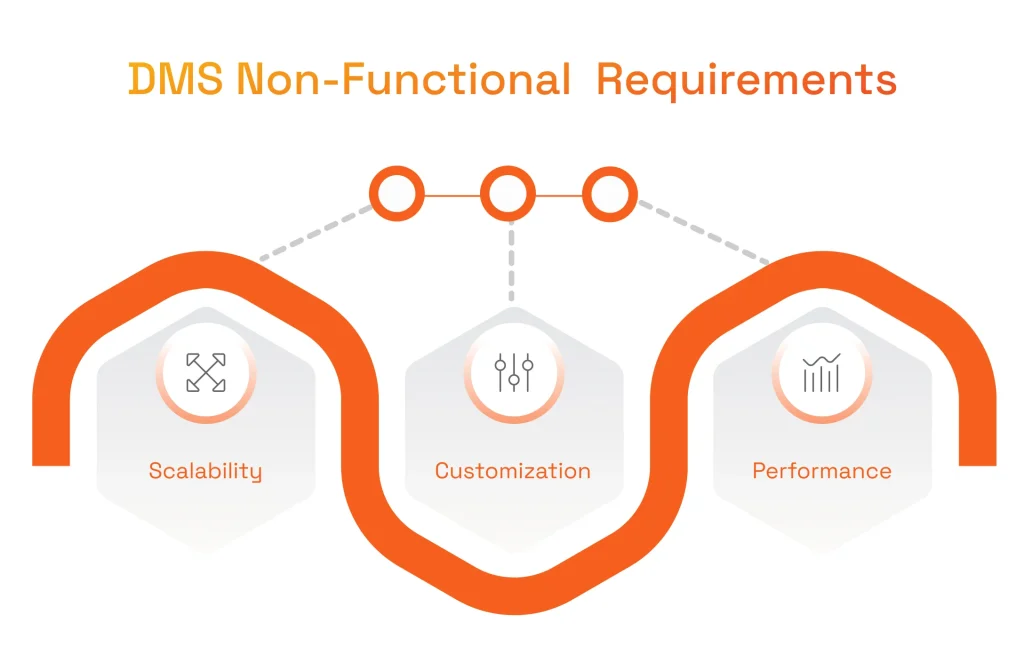
Scalability Requirements
Among the non-functional document management system technical requirements, Scalability Requirements are frequently the most important ones. Simultaneously, they may sometimes be quite elusive to define: here, one should proceed from a legal company’s future business needs and future business opportunities that may currently be hard to predict.
Because of this, before embarking on this part of your project planning, you should take a close look at similar legal businesses, the way they’ve been growing, and the growth opportunities they’ve had. This may give you insights as to the parts of your system that may have to be significantly expanded in the future.
Aside from that, your system must be scalable enough to support a much higher user concurrency and a much higher documentation volume than you can expect to have in the immediate or near future. Unless it’s Cloud Development you opt for, the software architecture of your legal DMS must necessarily allow for easily scaling the application by adding more system instances.
Lastly and importantly, it is an absolute must to have complete scalability for the user roles, user permissions and the related rights, document types, types of notifications, tasks, and workflows.
Customization Requirements
Your document management system must have the ability to support any future changes made to it in response to growing business needs. Simply put, nothing, or nearly nothing in your legal DMS must be cut in stone.
Your non-functional DMS system requirements must clearly state that the definitions of the user roles and document types, the related permissions and rights, file structure, and document templates must be completely modifiable.
Performance Requirements
Performance requirements aim to make sure that your system is capable of handling the tasks it is meant to handle at the speed and in the volume that you consider to be sufficient.
To define the corresponding target parameters, you need to indicate the required Response Time for the main operations (search, the various user interactions, etc.), Throughput (the number of transactions to be processed within a specified span of time), User Concurrency (the number of users your system is to support concurrently), and Uptime (the percentage of time that the system is to remain fully operational).
Operational Requirements
The operational requirements describe the ways users of your legal DMS are to interact with the system, the system’s interoperability, and its interactions with other systems.
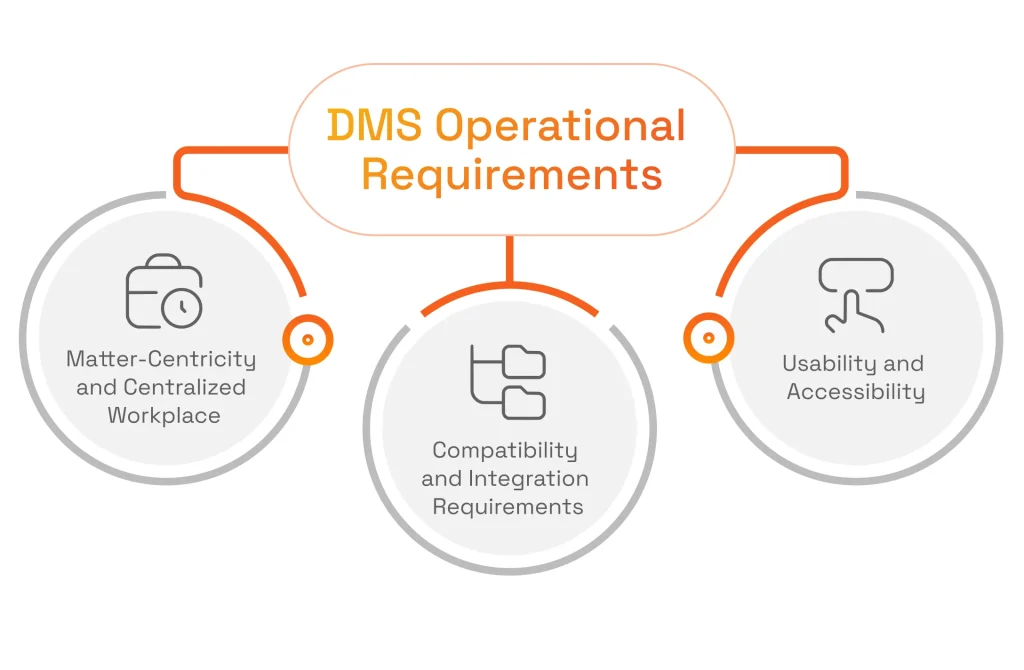
Matter-Centricity and Centralized Workplace
Legal document management systems are intended to store and manage sets of documents related to specific cases and legal matters.
While working on a case or legal matter, a lawyer needs to have all the related documentation handy. They also need to be able to manage conventiently all this documentation. Because of this, the business requirements for virtuallly any legal document management system must necessarily include Matter Centricity. This means that while accessing a case- or legal matter-related file or folder, the user must be able to easily access the entirety of the related documentation. Moreover, they must be able to perform any of the operations the application provides – editing, document sharing, creating tasks, and so on, from this point in the system.
Compatibility and Integration Requirements
Your legal DMS must be fully compatible with all the computers and devices used within your legal organization. Notably, it must also be compatible with a wide range of scanners.
Most probably, your document management system will also need to interact with other systems, like, for example, your case management software, or CRM. In this case, you need to make your software provider aware of the need for your DMS to import documents from these systems, or exchange information with them.
Compliance Requirements
To make your system compliant with the mandatory Data Protection regulations, you must discuss this matter at length with your IT provider and include all the required compliance in your document management system requirements. Based on the compliance requirements you indicate, your software provider will implement the functions needed to support the compliance regulations applicable in your geography.
Let’s briefly touch upon the requirements you need to embed support for in the case of GDPR:
- The Right of Access requirement – states that any of your clients is to be able to access all their personal data at any time they want.
- The Right to Be Forgotten requirement – stipulates that you be able to delete all of a client’s data.
- The Privacy by Design requirement – states that the very design of your system must prevent unauthorized data access within the application.
- The Data Portability requirement – says that your clients must be able to move their data to another system with ease.
- The Retention Control requirement – states that your document control solution must retain client data only for as long as it is required for processing.
- The Encryption requirement – states that all data must be encrypted using strong encryption.
- The Role-Based Access Control requirement – we’ve already previously dwelled on this requirement and it is a GDPR compliance requirement too.
Certainly, this quick overview of the Data Protection Compliance matters cannot provide you with all the knowledge you need to facilitate or control their implementation in your custom document management software.
Rather, it’s intended to show you that your employees in charge should approach the matter of compliance seriously enough, scrutinize the corresponding regulatory documentation, and make sure that your requirements for document management system clearly describe the ways in which the required compliance will be achieved.
How to Define the Requirements for Your Document Management System
Here is our step-by-step guide that will hopefully help you ensure efficiency, compliance, and scalability for your system.
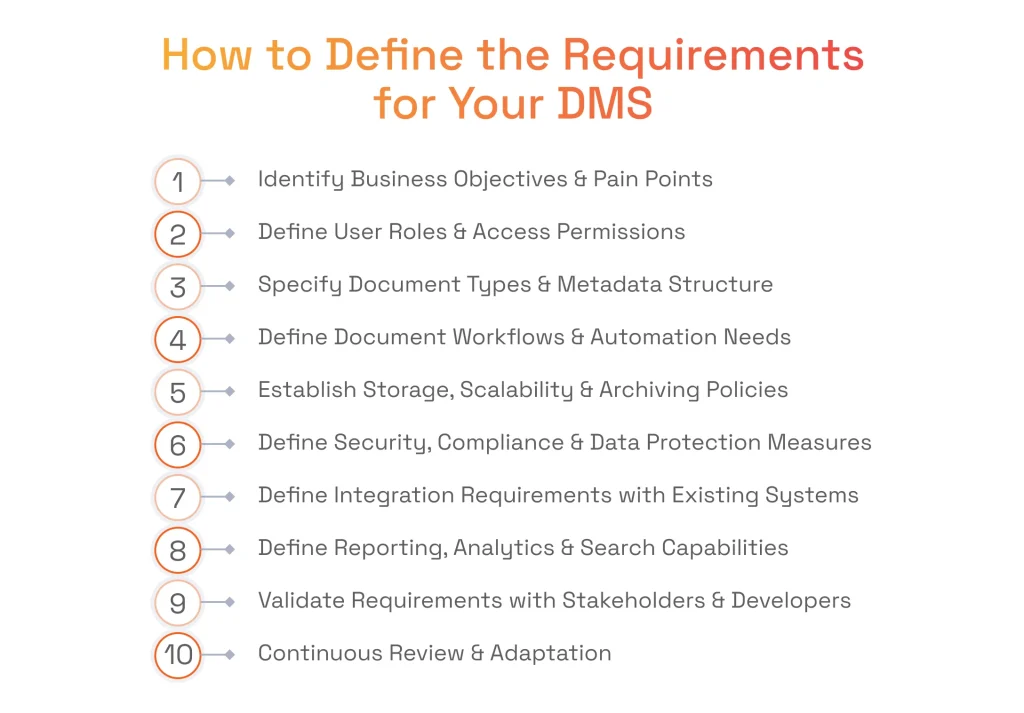
Step 1: Identify Business Objectives and Pain Points
It makes sense to start by determining why your company needs DMS in the first place. To achieve this, it is required to conduct stakeholder interviews with business leaders, department heads, and IT teams to uncover key challenges such as document retrieval delays, compliance risks, or inefficient workflows. It is vital to define specific business goals, for example, improving efficiency or cutting operational costs.
As a result of this stage, you will have a business needs report that outlines key objectives, pain points, and expected document management system benefits.
Step 2: Define User Roles and Access Permissions
Key functions of DMS include the support of different user roles to ensure strict control over document access. To prevent unauthorized access, it is mandatory to define user roles and establish Role-Based Access Control (RBAC). Additionally, it will be a smart move to implement audit logs to track document interactions for security and compliance purposes.
User roles and access matrix can be considered an output for this stage. The matrix should specify role-based permissions, security levels, and access control policies.
Step 3: Specify Document Types and Metadata Structure
Next comes the need to establish efficient document retrieval, categorize files, and define metadata attributes including document type, creation date, department, and tags. To achieve this, it is required to implement classification levels and enforce structured naming conventions, as well as version control policies.
Here should be formed a detailed document classification and metadata schema that defines document structure, searchability, and security classifications.
Step 4: Define Document Workflows and Automation Needs
Then, it is required to identify key workflows, for example, contract approvals or invoice processing, to define process stages from creation to archiving. It includes setting automation triggers, such as auto-routing approvals, as well as sending notifications for pending actions. Additionally, there should be e-signature requirements for legally binding approvals.
This results in a workflow process diagram that details document flow automation, approval stages, and notification mechanisms.
Step 5: Establish Storage, Scalability and Archiving Policies
It is critical to change the most appropriate type of storage, among on-premise, cloud-based and hybrid options. After that, the retention policies should be defined, for example, the duration of storing legal contracts. There should also be implemented some kind of disaster recovery plan, like a set of automatic archiving rules for inactive documents.
In the end, you should receive a storage and retention policy document, specifying storage structure, scalability plans, retention periods, and backup strategies.
Step 6: Define Security, Compliance, and Data Protection Measures
Safeguarding sensitive information is the most important part of any data-related initiative. The essential actions include implementing encryption for stored and transmitted data, defining strict access control policies, and enforcing Multi-Factor Authentication (MFA) for sensitive documents. It is also important to establish clear audit trails for tracking document modifications and define Data Loss Prevention (DLP) policies.
Here, you should have a complete security and compliance checklist, covering encryption standards, access controls, compliance measures (GDPR, HIPAA, ISO 27001), and data protection strategies.
Step 7: Define Integration Requirements with Existing Systems
An efficient DMS should easily integrate with all enterprise applications required by the business, including CRM, ERP, and e-signature platforms. To achieve this, the API connectivity requirements of the system should be defined, establishing data synchronization rules for seamless interoperability.
The output of this stage is a system integration plan with outlined required integration, API specifications, and data synchronization methods.
Step 8: Define Reporting, Analytics & Search Capabilities
Current market standards for modern DMS include the presence of advanced search capabilities like full-text search, AI-powered search, and Optical Character Recognition (OCR). It is also expected to have defined filtering options, custom dashboards, and compliance reporting.
As an outcome of this stage, a search and analytics requirements document should be created and mention search functionalities, filtering criteria, reporting needs, and audit log requirements.
Step 9: Validate Requirements with Stakeholders & Developers
Before the start of the document management system development process, it makes sense to validate all requirements through multiple stakeholder workshops and technical assessments. The goal is to prioritize features for an MVP and register changes of final document management requirements in Business Requirement Documents (BRD) and Functional Specification Documents (FSD).
So, when it is done, you will receive the finalized BRD and FSD, ensuring optimal alignment of technical and security aspects.
Step 10: Continuous Review & Adaptation
You should expect DMS to evolve as the business needs change. So, it makes sense to establish a feedback loop for users, monitor system performance, and refine workflows when needed. It will be smart to plan for scalability enhancements while ensuring compliance with regulatory changes.
An output at this stage will be an ongoing improvement strategy, aimed to refine and adapt document management requirements based on user feedback and evolving business needs.
The Challenges of Defining Document Management System Requirements
Some common roadblocks may negatively impact the implementation of the DMS system. In this section, we will discuss them and the most effective solutions.
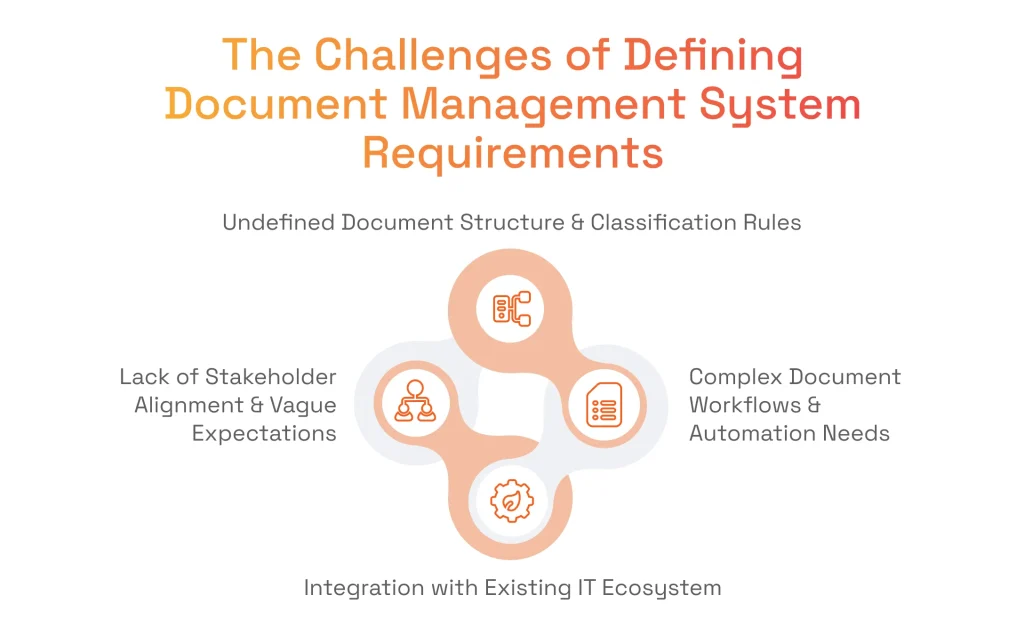
Lack of Stakeholder Alignment and Vague Expectations
Lacking clear alignment among stakeholders will eventually lead to conflicting priorities and unclear objectives during the formation of document control system requirements. With this misalignment comes inefficient workflows, poor user adoption, and expensive, time-consuming re-development of certain features.
We mitigate this risk by having a highly structured discovery phase. Our experts become responsible for conducting in-depth interviews with stakeholders, setting up requirement workshops, and process mapping sessions to consider all perspectives.
Undefined Document Structure and Classification Rules
Problems in this area lead to inconsistent storage, retrieval difficulties, and compliance risks. As a result, operational efficiency will be lowered, and time for searching for critical files significantly increased.
We implement intelligent document structuring powered by AI-based classification models. In particular, our experts implement features like automated tagging and full-text search capabilities to ensure a defined document structure.
Complex Document Workflows and Automation Needs
Manual handling of intricate document approval processes and compliance checks may lead to bottlenecks and human errors. Having inefficiencies here slows down the overall performance of the business, creating unnecessary security risks.
Our experts have proven experience in effective workflow automation thanks to Intelligent Process Automation and AI-powered decision-making. We know how to work with databases of any size, including projects with Big Data, and implement features including rule-based automation and smart notifications.
Integration with Existing IT Ecosystem
An isolated DMS requires employees to manually transfer data, increasing the risk of errors. So, poor or absent integration creates problems in existing workflows and complicates compliance across an entire organization.
Here, at SPD Technology, we excel at seamless integration with API-driven connectivity and industry-standard protocols. Our experts develop custom connectors for ERP, CRM, and сloud storage solutions for smooth data exchange.
Why Partnering with a DMS Development Vendor Is Beneficial For Your Project
Joining forces with an experienced vendor is a wise choice due to several major reasons. First and foremost, every custom DMS system requires significant investment in infrastructure and maintenance. An experienced vendor can assemble a skilled team without unnecessary overhead costs, which will ensure high ROI.
There is also a technological challenge since modern DMS systems are much more than solutions for the storage and retrieval of data. A proficient vendor will have the necessary expertise in AI-based automation, Data Analytics, and Natural Language processing for implementing advanced functionality following modern industry standards.
Having a professional at your side will ensure that there will be clear roadmaps, milestone tracking, and an Agile approach to project management. This will result in predictable timelines, reduced risks, and a seamless implementation process. In addition to that, you will be able to set up the necessary ongoing support with regular updates and security patches.
What Makes SPD Technology The Right Partner for DMS Development
SPD Technology has proven experience in building outstanding Document Management Systems (DMS) for businesses of any size. We deliver scalable, stable, and seamlessly integrated software for smooth data handling and exceptional collaboration.
Security is always a priority for us, and for DMS we implement industry best practices for encryption, access control, and regulatory adherence (GDPR, HIPAA, SOC 2). We ensure that sensitive documents are stored, shared, and processed securely while meeting industry-specific legal requirements.
Our DMS solutions streamline document processing with the help of AI-driven automation and our skills in data integration, providing efficient classification, metadata extraction, versioning, and approvals. We know how to minimize manual effort and boost productivity across the organizations of our clients.
Most importantly, our experts already delivered DMS solutions across entirely different industries, from legal to Fintech, so we know how to deal with industry-specific challenges and adapt to the new requirements in the shortest time possible.
Transforming Legal Tech Businesses with Robust DMS Systems – Our Success Stories
We delivered an array of DMS solutions for our clients, helping them increase operational efficiency, boost customer satisfaction, and unlock growth opportunities.
Overhauling and Expanding a Multi-Tenant Data Document Storage and Management Solution for a U.S. Technology Provider
Our client is a leading document management services provider from the USA with 30 years of experience.
Business Challenge
The challenge was rebuilding an existing system into a multi-tenant cloud application with a multi-tier user hierarchy, supporting digitizing, storing, sending, and managing functionality for multiple documents.
SPD Technology Approach
For this project, we created a dedicated team of vetted developers, QA engineers, and a PM who was working in close collaboration with a CTO on a client’s side. The team had expertise with AWS, so that’s why this technology was chosen for cloud infrastructure. Other key technological solutions included Auth0 for security and seamless integration and Terraform for streamlining infrastructure deployment and minimizing errors.
The development process highlights included building DB multi-tenancy, advanced search with multiple criteria, PDF editing, picture conversion, large ZIP archive creation, and a multi-tenancy auditing system. Implementing intricate role-specific permissions demanded precision on our part, as we delivered four user roles and seven customizable permissions. Our team successfully migrated the system to the cloud, improving maintainability and redesigning the UI to modern standards.
This project continues, with the next phase focused on migrating significant data volumes from the client’s legacy system, preparing a strong foundation for a potential intelligent automation services solution.
Value Delivered
- Unlocking Future Growth: by taking a solution to the cloud, we arranged new storage space for future clients.
- Boosted Customer Satisfaction: the new functionality we delivered transformed customer experience and significantly improved convenience.
- Streamlining Performance: our new solution improved file-downloading time 10x, compared to a previously existing system.
Overall, by overhauling and expanding a multi-tenant data document storage and management solution we build a powerful, modern system with an exceptional level of security, achieved by the implementation of DB multi-tenancy and the cloud disaster recovery option.
Developing a B2B Legaltech Solution for a LATAM Startup
The client is Legal Shelf, an established Mexico-city-based B2BLegaltech provider that works with Fortune 50 transnational companies.
Business Challenge
The challenge was to develop a cutting-edge feature-rich web application with AI/ML functionality and integrate the product with external systems.
SPD Technology Approach
We assembled a dedicated team to replace Legal Shelf’s outdated PHP system with a serverless AWS Lambda-based solution. As for other technologies, PostgreSQL was chosen for its OLTP/OLAP capabilities, and AWS S3 provided secure document storage.
We successfully migrated extensive legacy data and streamlined it through automation. A true technical highlight of this project was the custom-built full-text search engine in PostgreSQL, delivering high-performance, fuzzy-matching search capabilities.
After the core functionality was completed, we leveraged our AI/ML development services expertise to automate document management, leveraging NLP techniques like Named Entity Recognition and entity relation extraction. The system can classify documents, extract key details, and suggest actions. AI/ML models were trained on real legal documents and integrated via API.
Rigorous testing of the system included regression, accuracy, and performance evaluations, ensuring reliability.
Value Delivered
- Improved Performance: our advanced AI/ML models help employees of our client to extract information much faster, and this speed will increase over time.
- Elevated Customer Experience: the new platform made the core services more accessible for customers, with wider offerings and functionalities.
Ultimately, by developing a B2B Legaltech solution for a LATAM startup we delivered a highly customized solution that brought in significant cost savings, groundbreaking functionality, and limitless scalability compared to a previously existing legacy platform.
Conclusion
Composing the requirements for a document management system is a highly challenging task for any legal business and one that they should best tackle in collaboration with a seasoned provider of bespoke legal software.
It also definitely makes sense for you as a legal business to spend more time on reflecting upon your business needs and future goals and trying to define them better. You should make sure the business analysts of your software provider have access to this information.
As a provider of legal software development services, we are familiar with many DMS requirements, and would be glad to answer any related questions that you may have – just drop us a line.
FAQ
What are the backup and disaster recovery requirements for a Document Management System?
To effectively provide backup and disaster recovery, and prevent the loss of any piece of information, a DMS system should feature:
- Automated Backups: scheduled or real-time, depending on a specific situation.
- Redundancy: data should be stored in entirely different geographical locations.
- Versioning: There should be previous versions of documents to allow recovery from corruption.
- Restore Capabilities: Document management system features should include functionality to restore individual documents.
- Testing: Back-up and recovery functions should be regularly tested to ensure flawless performance.
- Security: Backups should be encrypted and protected by access controls.
How important is compliance in a Document Management System?
Compliance is critical for a document management solution, especially in highly regulated industries like finance, legal, and healthcare. It is instrumental in adhering to security standards, including HIPAA and GDPR. Data retention policies, secure access controls, and audit trails achieve exceptional compliance.
How important is scalability in a Document Management System?
Scalability is a key factor in the long-term viability of any document management software platform, as it accommodates the increase in document volume, number of users, and operational demands. Every successful organization is set to grow, so a scalable document management system and (DMS) will ensure peak system performance and help avoid costly data migration for a reasonable period.


